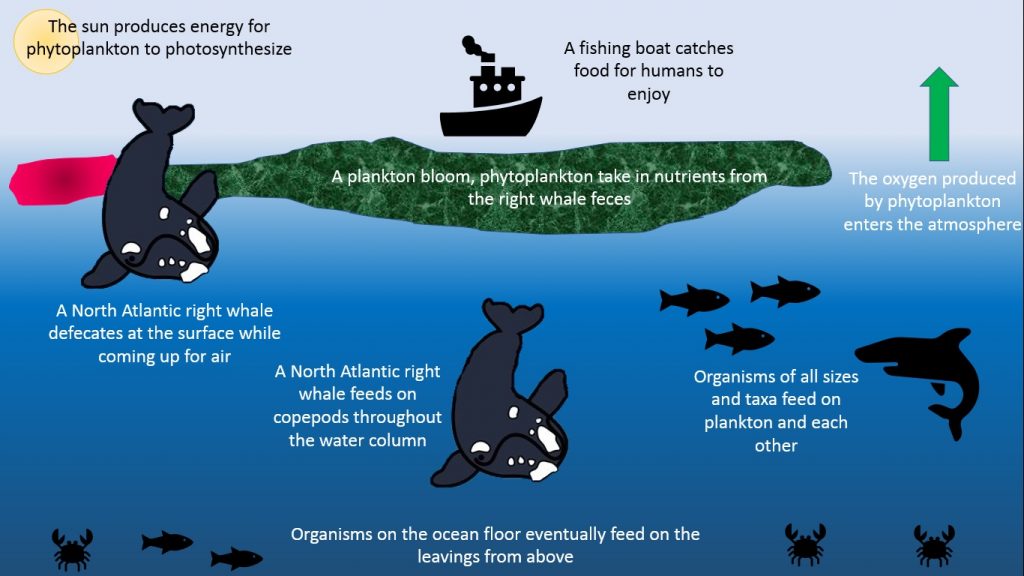
A recent study in the Gulf of Maine discovered the presence of marine mammals is a key factor in maintaining the fish population of the waters in the area. Specifically, the phenomenon that describes the process in whales is called the Whale Pump. Essentially, what happens is the whale surfaces to breathe and at the same time defecates. Then the whale dives down to feed on krill. While most often the nutrients go from the surface to the bottom of the ocean in what is called “marine snow”, in the case of whale feces the system is reversed, and the whale is actually bringing nutrients to the surface where other sea life can consume them. The whale feces floating on the surface helps phytoplankton growth. The phytoplankton absorbs carbon dioxide which it brings to the ocean floor. Whale feces provide iron which aids the growth of phytoplankton.
It is a complicated process, but thanks to the whale, very efficient at not only keeping the air fresh but also feeding numerous species of fish and flushing carbon dioxide from the air. The process makes whale poop an enormous asset to marine ecosystems.

Conservation biologist John Roman from the University of Iceland explains that since most whales eat a diet of fish, it is likely you will find scales and squid beaks in their poop. As well as a lot of nutrients and micronutrients.
It appears that the researchers who had been studying the whale pump theory were underestimating just how much feces was produced. It is understandable that since you cannot easily put a whale in a tank and take accurate measurements that any estimate heretofore was inaccurate. The Smithson magazine reports; “New research co-authored by Nicholas Pyenson, curator of fossil marine mammals at the Smithsonian’s National Museum of Natural History, shows evidence that the world’s largest whales have been sold short. The study published today in the journal Nature finds that gigantic baleen whales—such as blue, fin and humpback whales—eat an average of three times more food each year than scientists have previously estimated. By underestimating how much these whales eat, scientists may also have been previously underestimating the importance of these undersea giants to ocean health and productivity.
Since whales eat more than previously thought, they also poop more, and whale poop is a crucial source of nutrients in the open ocean. By scooping up food and pumping out excrement, whales help keep key nutrients suspended close to the surface where they can power blooms of the carbon-absorbing phytoplankton that form the base of ocean food-webs. Without whales, those nutrients more readily sink to the seafloor, which can limit productivity in certain parts of the ocean and may in turn limit the capacity of ocean ecosystems to absorb planet-warming carbon dioxide.
The findings come at a pivotal moment as the planet faces the interconnected crises of global climate change and biodiversity loss. As the planet warms, the oceans absorb more heat and become more acidic, threatening the survival of food sources that whales need. Many species of baleen whales also have not recovered from industrial whaling during the 20th century, remaining at a small fraction of their pre-whaling population sizes.
Our results say that if we restore whale populations to pre-whaling levels seen at the beginning of the 20th century, we’ll restore a huge amount of lost function to ocean ecosystems,” Pyenson said. ‘It may take a few decades to see the benefit, but it’s the clearest read yet about the massive role of large whales on our planet.’
Surprisingly, some basic biological questions remain unanswered when it comes to the world’s biggest whales. Marine ecologist and Stanford University postdoctoral fellow Matthew Savoca, one of Pyenson’s collaborators and lead author of the study, found himself confronted by one of these remaining mysteries: how much the massive filter-feeding baleen whales ate each day.
Savoca said the best estimates he encountered from past research were guesses informed by few actual measurements from the species in question. To crack the conundrum of just how much food 30- to 100-foot whales eat, Savoca, Pyenson and a team of scientists used data from 321 tagged whales spanning seven species living in the Atlantic, Pacific and Southern Oceans collected between 2010 and 2019.”
What the whales eat has a direct connection to the color of the feces. Whales that eat krill, found at the lower levels of the ocean produce feces that is red in color and high in iron. Whales like the humpback, which eat mainly fish, excrete feces that is brown in color. The North Atlantic right whales eat three species of copepods which are a type of zooplankton that are crustaceans just like crabs and lobsters. The copepods are smaller than a grain of rice.
It is estimated that before the devasting whale hunting days of pre-1900, baleen whales in the Southern Ocean consumed 430 million tons of Antarctic krill annually. Baleen whales were maintaining the krill stocks on which they were feeding, but the ecosystem collapsed when the whales were hunted and killed.
Whale poop is not to be confused with ambergris. Ambergris, it is believed, is formed when the sperm whale ingests some sharp object. The object is covered with an orange coating that is then excreted. It is very valuable and used for creating exotic perfumes.
The giant of the seas with its history of having provided the first oil for the world’s lamps, the basis for exotic perfumes and employment for generations of whalers not to mention fodder for the creative mind of Herman Melville, is now recognized to be playing an important role in the ecosystems of the oceans and the air we breathe.
